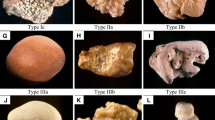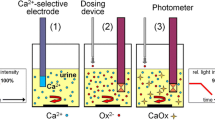Summary
Stone and urine composition were analysed in 75 men and 40 women with recurrent calcium oxalate stone disease (group R) and in 48 men and 19 women who had formed only one calcium-oxalate-containing stone (group S). Patients who had developed stones with a large fraction of calcium phosphate were significantly more frequent in group R than in group S. There was furthermore a higher excretion of calcium and higher calcium oxalate supersaturation levels in patients with stones containing more than 25% calcium phosphate. It was concluded from these observations that the calcium phosphate content of renal stones might be a useful factor in predicting the future course of the disease.
Similar content being viewed by others
References
Achilles W, Jöckel U, Ulshöfer B, Riedmiller H (1992) In vitro formation of “urinary stones”: spheric growth of calcium oxalate on spherules of amorphous calcium phosphate in gel matrix (abstract). In: Ryall RL (ed) VIIth international symposium on urolithiasis, Cairns. Flinders Medical Centre, Bedford Park, Australia, p 116
Ahlstrand C, Tiselius HG (1990) Recurrences during a 10-year follow-up after first renal stone episode. Urol Res 18:397–399
Baumann JM (1985) Can the formation of calcium oxalate stones be explained by crystallization process in urine? Urol Res 13:267–270
Berg C, Tiselius HG (1989) The effects of citrate on hydroxyapatite induced calcium oxalate crystallization and on the formation of calcium phosphate crystals. Urol Res 17:167–172
Berg W, Schneider HJ, Hesse A (1976) Crystal optical findings on calcium oxalate of uric concretions. In: Fleisch H, Robertson WG, Smith LH, Valensieck W (eds) Urolithiasis research. Plenum Press, New York, pp 241–248
Berg C, Larsson L, Tiselius HG (1990) Effects of different doses of alkaline citrate on urine composition and crystallization of calcium oxalate. Urol Res 18:134–316
Blacklock NJ (1968) The pattern of urolithiasis in the Royal Navy. In: Hodgkinson A, Nordin BEC (eds) Proceedings of renal stone research symposium, Leeds. Churchill, London, pp 33–47
Coe F, Parks JH (1990) Defenses of an unstable compromise: crystallization inhibitors and the kidney's role in mineral regulation. Kidney Int 38:625–631
Grases F, Conte A (1992) Urolithiasis: inhibitors and promoters. Urol Res 20:86–88
Grases F, Conte A, Gil JJ (1988) Simple method for the study of heterogenous nucleation in calcium oxalate urolithiasis. Br J Urol 61:468–473
Hallson PC, Rose GA (1989) Measurement of calcium phosphate crystalluria: influence of pH and osmolality and invariable presence of oxalate. Br J Urol 64:458–462
Hallson PC, Rose GA (1989) Risk factors for urinary calcium oxalate crystals as revealed by their specific enzymatic assay. Br J Urol 64:451–457
Hermann U, Schwille PO, Kuch P (1991) Crystalluria determined by polarization microscopy: technique and results in healthy control subjects and patients with idiopathic recurrent calcium urolithiasis classified in accordance with calciuria. Urol Res 19:151–158
Herring LC (1962) Observations on the analysis of ten thousand urinary calculi. J Urol 88:545–562
Hodgkinson A (1977) Human and animal pathology. In: Oxalic acid in biology and medicine. Academic Press, New York, pp 223–253
Koutsoukos PG, Sheehan ME, Nancollas GH (1981) Epitaxial considerations in urinary stone formation. II. The oxalatephosphate system. Invest Urol 18:358–363
Larsson L, Sörbo B, Tiselius HG, Öhman S (1984) A method for quantitative wet-chemical analysis of urinary calculi. Clin Chim Acta 140:9–20
Leusmann D, Blaschke R, Schwandt W (1990) Results of 5035 stone analyses: a contribution to epidemiology of urinary stone disease. Scand J Urol Nephrol 24:205–210
Lonsdale K (1968) Human stones. Science 159:1199–1207
Meyer JL, Bergert JH, Smith LH (1977) Epitaxial relationships in urolithiasis: the brushite-whewelllite system. Clin Sci Mol Med 52:143–148
Nancollas GH (1983) Crystallization theory relating to urinary stone formation. World J Urol 1:131–137
Öhman S, Larsson L, Tiselius HG (1991) Clinical significance of phosphate in calcium oxalate urinary calculi. Ann Clin Biochem 28:59–63
Pak CYC (1969) Physicochemical basis for formation of renal stones of calcium phosphate origin. J Clin Invest 48:1914–1922
Pak CYC (1981) Potential etiologic role of brushite in the formation of calcium (renal) stones. J Cryst Growth 53:202–208
Pak CYC, Eanes ED, Ruskin B (1971) Spontaneous precipitation of brushite: evidence that brushite is the nidus of renal stones originating as calcium phosphate. Proc Natl Acad Sci USA 68:1456–1460
Robertson WG, Peacock M (1980) The cause of idiopathic calcium stone disease: hypercalciuria or hyperoxaluria. Nephron 26:105–110
Robertson WG, Peacock M, Nordin BEC (1968) Activity products in stone forming and non-stone forming urine. Clin Sci 34:579–594
Strauss AL, Coe F, Deutsch L, Parks JH (1982) Factors that predict relapse of calcium nephrolithiasis during treatment. Am J Med 72:17–24
Sutor DJ, Wooley SE, Illingworth JJ (1974) A geographical and historical survey of the composition of urinary stones. Br J Urol 46:393–407
Tiselius HG (1982) An improved method for the routine biochemical evaluation of patients with recurrent calcium oxalate stone disease. Clin Chim Acta 122:409–418
Tiselius HG (1987) Measurement of the risk of calcium phosphate crystallization in urine. Urol Res 15:79–81
Tiselius HG (1989) Standardized estimate of the ion-activity product of calcium oxalate in urine from renal stone formers. Eur Urol 16:48–50
Tiselius HG (1991) Aspects of estimation of the risk of calcium oxalate crystallization in urine. Urol Int 47:255–259
Tiselius HG (1992) Recurrent stone formation in patients treated with ESWL. J Stone Dis 4152–157
Williams RE (1963) Long-term survey of 538 patients with upper urinary tract stone. Br J Urol 35:416–437
Zarembski PM, Grieve J (1976) Analysis of urinary stones using infra-red spectroscopy and scanning electron microscopy: progress report. In: Fleisch H, Robertson WG, Smith LH, Valensieck W (eds) Urolithiasis Plenum Press, New York, pp 371–374
Author information
Authors and Affiliations
Rights and permissions
About this article
Cite this article
Tiselius, HG., Larsson, L. Calcium phosphate: an important crystal phase in patients with recurrent calcium stone formation?. Urol. Res. 21, 175–180 (1993). https://doi.org/10.1007/BF00590033
Received:
Accepted:
Issue Date:
DOI: https://doi.org/10.1007/BF00590033




